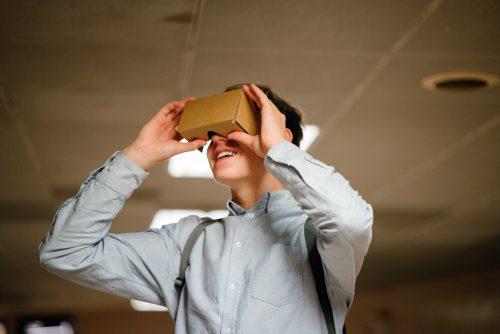Will Blockchain Drive AR Adoption?
Although it has been around in practice for far longer than virtual reality (VR), proponents of augmented reality (AR) tools have been hard-pressed to define the technology’s growth as successful. The tech world has long recognized AR’s potential, and the sector has notched some serious accomplishments, such as the wildly popular Pokémon GO. Yet, initiatives undertaken by major tech companies—including Google’s failed Google Glass—have largely fizzled despite AR’s significant potential in the areas of marketing, gaming, and architecture to name a few clear-cut applications.
AR’s failure to launch stems from a variety of factors, starting with the practical (ergonomics) to the technical (infrastructure than can provide a smooth, seamless experience). However, despite the seemingly insurmountable challenges, the sector is now poised to break free from its historical disappointments. Several companies have started merging blockchain and AR, and the results are encouraging. With blockchain’s penchant for disruption, AR may finally have the tools needed to unlock its true potential.
Breaking the Mold
AR’s adoption problem has little to do with its potential. Indeed, the technology is already used in specialized situations—Snapchat’s photo filter, the aforementioned Pokémon Go and similar games—there has yet to be a breakthrough that is accompanied by mass adoption. Major obstacles standing in the way of meeting these ambitions relates to the technology’s current usability and ergonomics.
While recent developments make AR easier to implement in practice—anyone can point their phone camera at an object—the technology itself isn’t conducive to long-term usage. Google Glass had a serious image problem as they were too unwieldy and large to be anything but a novelty for tech enthusiasts.
Moreover, the technology, despite its potential, has been hampered by a lack of real use cases. While mobile games can harness its benefits and social media uses it for gimmicks, marketers—one of the biggest natural markets for AR—have remained largely on the sidelines, though this trend may be gradually shifting. Thanks to the smartphone revolution alongside innovations like blockchain, AR is finally poised to step into the spotlight. While smartphones support the perfect platform for easy AR implementation, blockchain delivers a more transparent and streamlined experience.
Blockchain’s Disruption Reaches AR
As the VR sector has already shown the world with apps like Decentraland—a blockchain-based VR world simulator—blockchain can have a resounding impact on the AR industry. Mobile games are already taking advantage of this under-tapped potential, and other sectors are contemplating a jump into the fray. Retailers, for instance, can deploy AR to help customers visualize what a product would look like by allowing prospective shoppers to “try on” clothes superimposed on pictures or actual footage of the users.
Blockchain is ideal as an infrastructure for AR for a few reasons. Marketing and advertising, alongside entertainment, remain the biggest areas of potential expansion for AR. Blockchain provides significant upgrades for all three, including improved data-gathering, greater privacy protections, better resource allocation, and heightened transparency.
Apart from these attributes, incorporating blockchain means enhanced democratization and decentralization, which will inevitably shift power from middlemen and brokers towards content creators and consumers. Ceek—a VR entertainment firm—for instance, is looking to expand its VR offerings into AR by using blockchain. The company’s VR offerings—which include immersive VR concert experiences from major names like U2 and Lady Gaga—are set to expand into AR with the company’s new educational efforts. Eventually, the goal is to improve classroom teaching and learning by promoting a more active and engaging performance experience.
Others, like hardware maker Lucyd, are seeking to create new peripherals that are designed to help the technology expand. The company’s decentralized marketplace for apps uses blockchain to reduce friction and improve peer-to-peer interactions.
Blockchain also aids developers of AR technology by providing more affordable resources and processing power. Companies like RNDR and Leonardo Render are building decentralized processing farms that rent out scalable processing power for developers in need. Already in use for VR, extending the use case for AR means that developers and companies can build apps and solutions without worrying about rapidly rising hardware and rendering costs.
Even for marketers, AR and blockchain demonstrate significant upgrades in the realms of targeting and ad success. Instead of forcing consumers to view their content and participate in AR experiences they would prefer to avoid, companies can reward viewers for opting in to advertising and data collection, ultimately providing more relevant results and insights for marketers.
A Door to Adoption
Blockchain offers an intriguing infrastructure upgrade for existing AR solutions. Instead of relying on the same outdated models that spur more friction than success, companies shifting to blockchain are discovering that they can extract greater value from the decentralized technology thanks to its numerous advantages.
Improvements in data collection and privacy taken in tandem with significant strides in processing capacity and technology mean AR can fully flourish in an ecosystem that prioritizes users while creating a real incentive to participate. As the two technologies become further intertwined, both will continue to evolve while building a lasting foundation for these technologies to thrive.

